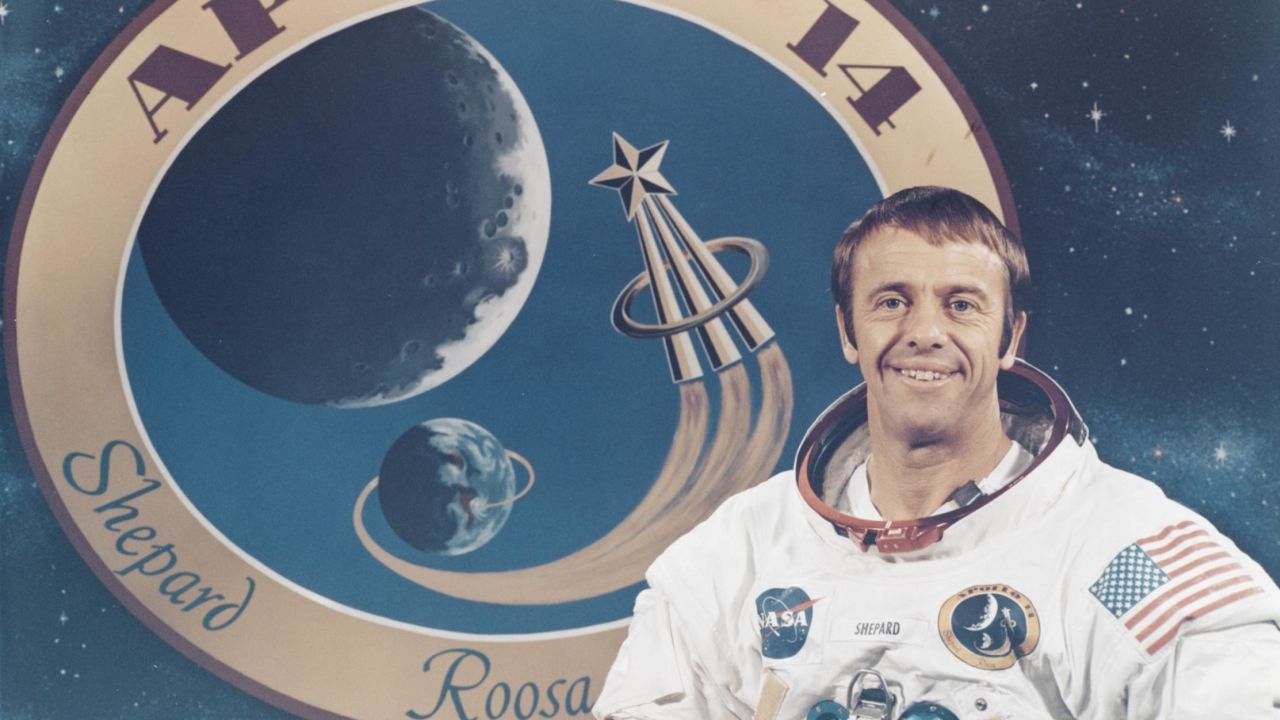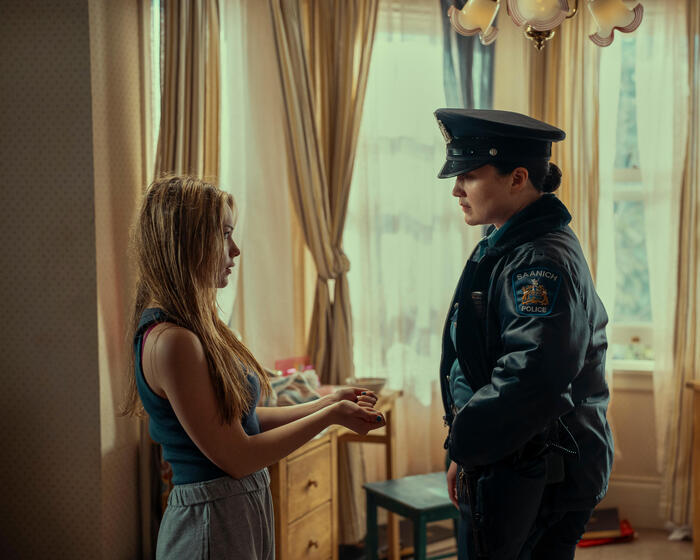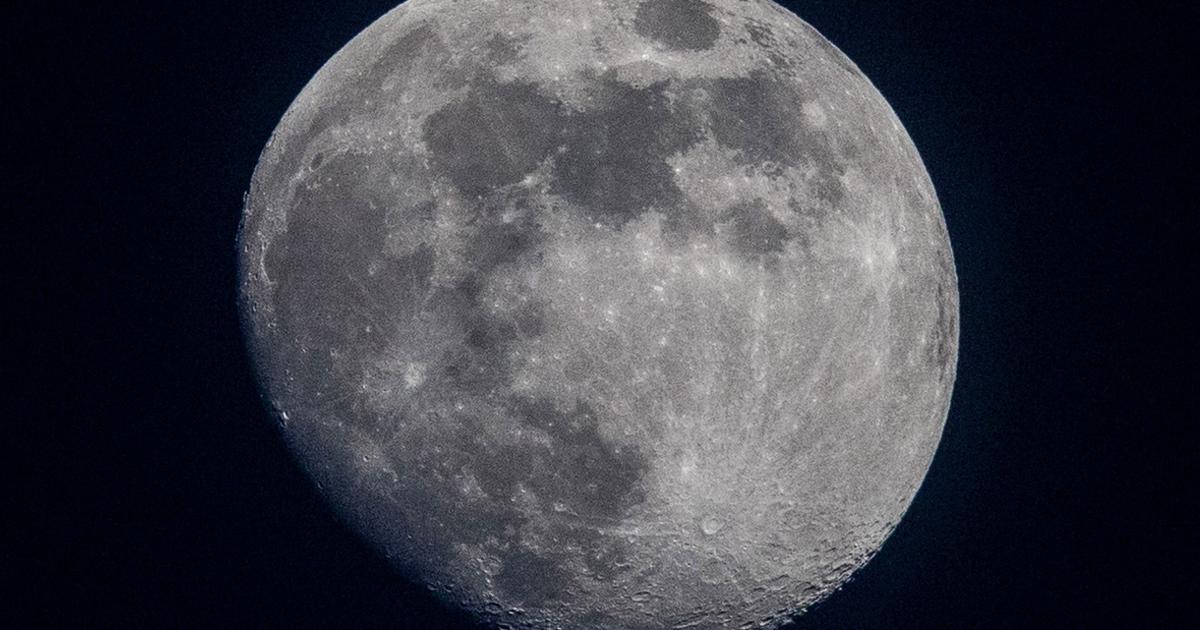Look at the amazing images of the Orion spacecraft, the Earth and the Moon 0:48
(CNN) --
February 6, 1971 was a relatively quiet day for American sports.
Larry Costello's Milwaukee Bucks swept the San Francisco Warriors in the NBA;
the Boston Bruins defeated the Buffalo Sabers to continue an eight-game NHL unbeaten streak, and Arnold Palmer shot 68 to tie for the lead at the Hawaiian Open.
Nothing out of this world could be said, incorrectly.
Because some 380,000 kilometers away, Alan Shepard was playing golf on the Moon.
Shepard's exploits on Apollo 14, the eighth crewed Apollo mission and the third to land on the lunar surface, were broadcast to televisions on Earth in grainy images and left viewers, including mission controllers, stunned. In Houston.
Awesome!
The Artemis I mission captures the Orion spacecraft, the Earth and the Moon in a single image
Shepard, an avid golfer, had asked Jack Harden, a pro at River Oaks Country Club in Texas, to build him a modified club.
The resulting creation, a Wilson Staff Dyna-Power 6 iron head, was stowed in Shepard's spacesuit for launch, with a few balls hidden in a sock.
None of this was listed in the NASA inventory.
The Apollo program cost nearly $25 billion, or about $246 billion today, according to a 2019 analysis by The Planetary Society, giving new meaning to the phrase "time is money."
With minutes worth millions, moonwalk calendars followed a meticulously designed strategy to ensure maximum efficiency.
advertising
It is rumored that only mission director Bob Gilruth knew of the astronaut's plan, and that Shepard obtained Gilruth's reluctant permission only on the promise that any golfing would be saved for the end of extravehicular activities (EVA). , and only if there was time.
Shepard poses in front of the Apollo 14 mission insignia, in 1970. Credit: Space Frontiers/Archive Photos/Getty Images
After nine hours of walking on the surface and various scientific experiments, Shepard was returning to the lunar module when he saw his opportunity.
Connecting the head of a modified club to a tool designed to collect lunar rock samples, the commander prepared to face one of the largest sandbanks in the universe, single-handed.
"Houston... you might recognize what I'm holding in my hand as the contingency sample return handle. It just so happens to have a real six iron on the bottom," Shepard said, speaking directly into the camera.
"In my left hand, I have a little white ball that is familiar to millions of Americans... Unfortunately, the suit is so stiff, I can't do this two-handed, but I'm going to try a little sand shot here." .
After two failed attempts, Shepard's first shot slammed into a nearby crater, much to the delight of capsule communicator Fred Haise in Houston.
"That sounded like a
slice
to me , Al," Haise said, but the first golfer from the Moon had one ball left to play.
Kicking up plumes of moondust, the second shot came off better, and Shepard liked what he saw.
"Miles and miles and miles," the astronaut commented excitedly as the ball faded out of sight, swallowed up by the infinite blackness of space.
Needless to say, the shot tracking technology was unavailable, so Shepard returned to Earth unaware of the whereabouts of his second shot.
Alan Shephard lining up a shot in December 1995. Credit: JD Cuban/Getty Images North America/Getty Images
camera shy
Three years later, in the North West of England, Andy Saunders was born.
After graduating with a degree in photography from Loughborough University, he carved out a career in the property renovation industry.
What does all this have to do with an astronaut playing golf on the moon?
Nearly 50 years later, Saunders would be the man to prove that the astronaut's second shot actually traveled only 120 feet, about the length of two 10-pin bowling alleys.
Saunders has been obsessed with space since his childhood.
Credit: Andy Saunders
Saunders hadn't set out to spoil Shepard's party.
Instead, he began with a nagging desire to make amends for a lifelong frustration, expressed clearly in a 2012 article in The Atlantic titled "No Good Photos of Neil Armstrong on the Moon."
Because although Armstrong was the astronaut in charge of taking a small step for man, he was also the astronaut in charge of the cameras.
As a result, effectively all of the iconic images of astronauts captured on the surface during Apollo 11 are from Buzz Aldrin.
About 386,000 km and 76 hours of travel: this was the first trip of man to the Moon
"If you think about today's world, how absolutely ridiculous that concept is; the first person in another world, but they only brought a camera," Saunders told CNN.
"They didn't take a selfie like we would now."
Using a modern digital enhancement technique known as stacking, whereby frames are separated and then stacked and consolidated for more detail, Saunders produced the sharpest image of Armstrong on the Moon.
When he posted the image on the 50th anniversary of Apollo 11, in July 2019, it made world news.
Soon after, NASA opened up an extensive library of Apollo flight films, long sealed in a frozen vault at the Johnson Space Center in Houston, and Saunders applied his techniques to them.
NASA original 16mm film of Armstrong on the lunar surface (L), and the restored version of Saunders (R).
Credit: NASA/Andy Saunders
Faced with 35,000 still photos and more than 10 hours of film, for the next two years he put his professional career on hold to spend more than 10,000 hours restoring each and every frame.
The result was "Apollo Remastered," a book of Saunders' 400 stunning favorite images that show the space program with unprecedented clarity.
The book's cover, an image of Apollo 9 astronaut Jim McDivitt, perfectly encapsulates the magic of Saunder's restoration techniques.
Before it was an image of near-total darkness, save for a faint outline of McDivitt's helmet, and it's hard to believe that the illuminated, cinematic portrait could be lifted from the original.
Apollo 16 astronaut Charlie Duke described the images as an "accurate representation" of his memories on the Moon, "the closest thing to being there."
For Saunders, there is no better assessment.
"I want people to feel like this is the closest thing to walking on the Moon themselves," he said.
"Think about the issue for any photographer: you have other humans doing these incredibly extraordinary things in an extraordinary place with a backdrop that is literally otherworldly."
"Every several hundred images I review, there is something of interest, something of importance, or something that just seems incredible."
NASA's rare moon dust collected by Neil Armstrong on the Apollo 11 mission is up for auction
Shooting Stars
When he arrived at Apollo 14, Saunders was tasked with finding Shepard's elusive second ball.
Finding it in the original murky images, in which almost everything on the surface resembled small rocks, became an impossible game of "Where's Waldo?"
interstellar, but with Saunders' series of tricks, he quickly found his prize.
Calculating the distance the ball had traveled was a bit more complicated, since there was no reference for the scale.
Saunders' solution was to superimpose the images on captures from the Lunar Reconnaissance Orbiter, a satellite that orbited the Moon in 2009.
Without wind or erosion, nothing had moved;
the scene had been perfectly preserved for 38 years, and Saunders had his answer: 36 meters.
Some 290 meters short of the average driving distance on the 2022 PGA Tour, even the most casual golfer would consider that initial shot a disaster.
But casual golfers aren't playing in a restrictive, bulky space suit and thick gloves, they're not swinging a weightless club in one-sixth Earth's gravity, they can barely see their feet, and, with the exception of a certain star from TikTok, they're not swinging the stick with just one hand.
Saunders' restoration finally revealed the location of Shepard's second ball.
Credit: NASA/Andy Saunders
"He couldn't put the ball in his favor, he just dropped it, full of rocks and tracks and like an unraked bunker, so even making contact, I think it was pretty impressive," Saunders said.
Saunders believes Shepard's "miles and miles" comment was made as a joke, an almost knee-jerk reflection of his hyper-competitive and "feisty" nature.
The fact that Shepard – who died at the age of 74 in 1998 – later lowered his estimate to a generous 200 meters seems to corroborate this assessment.
And yet, ironically, there was some innate truth behind the astronaut's bold claim.
By Saunder's calculations, if famed player Bryson DeChambeau were able to replicate the speed of his clubhead on Earth at a 45-degree angle on the Moon, he'd hit his shot 5km.
"So actually, interestingly, it's miles and miles and miles as Shepard said," Saunders added.
"It's possible, given a suit that's flexible enough... because there's no air resistance, because there's one sixth of gravity, you could hit almost the length of an entire golf course."
Shepard is lifted into the helicopter after splashing down in the Atlantic Ocean aboard the Mercury capsule in May 1961. Credit: AFP via Getty Images
Whoever finds it keeps it
With the launch of the Artemis I spacecraft earlier this month, NASA is nearing the long-awaited return to the surface of the Moon, which has been untouched by humans since the last steps of Apollo 17 astronaut Gene Cernan. , in December 1972.
In theory, this could make Saunders a millionaire.
A 2021 ESPN article pegged the auction value of each ball at a minimum of US$10 million, with Saunders joking that he would go after NASA for their 10% fee if they were recovered.
Though Saunders isn't planning an early retirement just yet.
He is content with his conviction that the site of Shepard's exploits will never be disturbed, a belief supported by NASA chief historian Brian Odom.
"Maybe one day we'll have colonies on the moon and it's like Stonehenge: we don't want to mess with the Apollo landing sites," Odom said.
"We want to make sure that we treat these landing sites as national monuments, make sure that they're preserved, that they don't get contaminated, that they're there in perpetuity."
"I think [the balls] are where they need to be and we have to make sure they stay the way they are."
Shepard is honored with one of two USPS stamps released in 2011, to celebrate Project Mercury and the MESSENGER Mission, respectively.
Credit: Bill Ingalls/NASA/Getty Images
Their hopes touch on something that has contributed to the enduring legacy of Shepard's golf shot: not its distance or monetary value, but its human relevance.
Oddly enough, by the time of Apollo 14, Odom explained, the American public had developed a desensitized "I've seen it" attitude toward the space program, and the prospect of a predominantly scientific research mission didn't change the mood. .
All that changed with the news of the arrival of golf on the Moon, even more so because of the man who wielded the club.
As the first American astronaut in space in 1961, Shepard, a World War II Navy veteran, had become a national celebrity, a remedy to the embarrassment that Yuri Gagarin of the Soviet Union arrived before the United States. to space.
"People love Shepard, they know him," Odom explains.
"It seems like sometimes a lot of people want to look like Alan Shepard."
"The people who knew Shepard, who I've talked to, had that zest for life. He had that appreciation for doing his job, but also having fun...those two things come together in that moment on the Moon when it's hitting golf balls".
Shepard's EVA suit on display at the Kennedy Space Center Visitor Complex in Cape Canaveral, Florida.
Credit: Matt Stroshane/Getty Images
Longest
drive
in history or not , Shepard's Lunar Golf Exhibition has captured the imagination for half a century, and not just golf aficionados.
"We always talk about getting to the Moon, landing on it and going back to Earth: that's how we think of the Moon," says Odom.
"But when it's a human activity, something done just for the joy of being alive, that's something people can appreciate."
Saunders agrees.
"A lot of people know that somebody played golf on the Moon," she said, "but not a lot of those people would know that it was Apollo 14, that there was even an Apollo 14."
"Those human moments resonate forever."
AstronautMoon












/cloudfront-eu-central-1.images.arcpublishing.com/prisa/KMEYMJKESBAZBE4MRBAM4TGHIQ.jpg)


